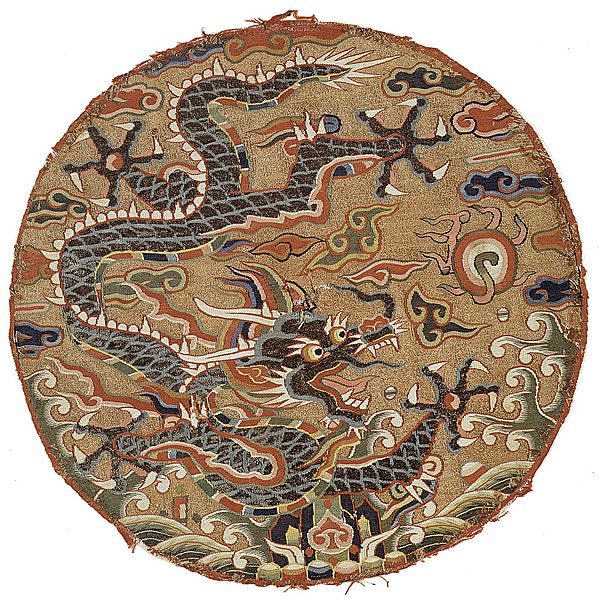Image: Kesi roundel with five-clawed dragon design

Description: Kesi roundel with five-clawed dragon design, China, late 17th century. Silk, metallic thread and peacock feather slit-tapestry weave, 0.30 x 0.31 m (11¾” x 12½”). Metropolitan Museum of Art, New York, Fletcher Fund, 36.65.32 Native to the Indian subcontinent, the peacock (Pavo cristatus) has long been prized in South Asia and further afield for its brilliant blue-green colouring and showy ocelli tail feathers—around 200 of which make up a mature bird’s train. These are moulted and regrown annually. Occasionally, individual peacock feather barbules were wrapped around thread and woven into 16th- and 17th-century Ottoman and Chinese textiles. Such iridescent thread is used to great effect in this Qing-dynasty (164 4–1911) kesi slit-tapestry where it is perfectly placed, among silk and metal threads, to highlight the scales of a fiercely animated fiveclawed imperial dragon, claws flexed, eyes bulging, teeth bared. Using the interlocking tapestry technique, in a different material and on a larger scale, is a late 19th-early 20th-century dhurrie from north India. Such utilitarian cotton flatweaves were traditionally used by all levels of Indian society as bed covers, prayer mats and floorcovers for rooms, festivals or palaces from at least the 17th century.
Title: Kesi roundel with five-clawed dragon design
Credit: https://hali.com/news/thread-of-time-a-qing-kesi-roundel-and-an-indian-cotton-dhurrie/?mc_cid=8721d6bac1&mc_eid=d6213a7b73
Author: Hali photographer? Or museum? Artwork by unknown Chinese weaver
Permission: This is a faithful photographic reproduction of a two-dimensional, public domain work of art. The work of art itself is in the public domain for the following reason: Public domainPublic domainfalsefalse This work is in the public domain in its country of origin and other countries and areas where the copyright term is the author's life plus 100 years or fewer. You must also include a United States public domain tag to indicate why this work is in the public domain in the United States. This file has been identified as being free of known restrictions under copyright law, including all related and neighboring rights. https://creativecommons.org/publicdomain/mark/1.0/PDMCreative Commons Public Domain Mark 1.0falsefalse The official position taken by the Wikimedia Foundation is that "faithful reproductions of two-dimensional public domain works of art are public domain". This photographic reproduction is therefore also considered to be in the public domain in the United States. In other jurisdictions, re-use of this content may be restricted; see Reuse of PD-Art photographs for details.
Usage Terms: Public domain
License: Public domain
Attribution Required?: No
Image usage
The following page links to this image:

